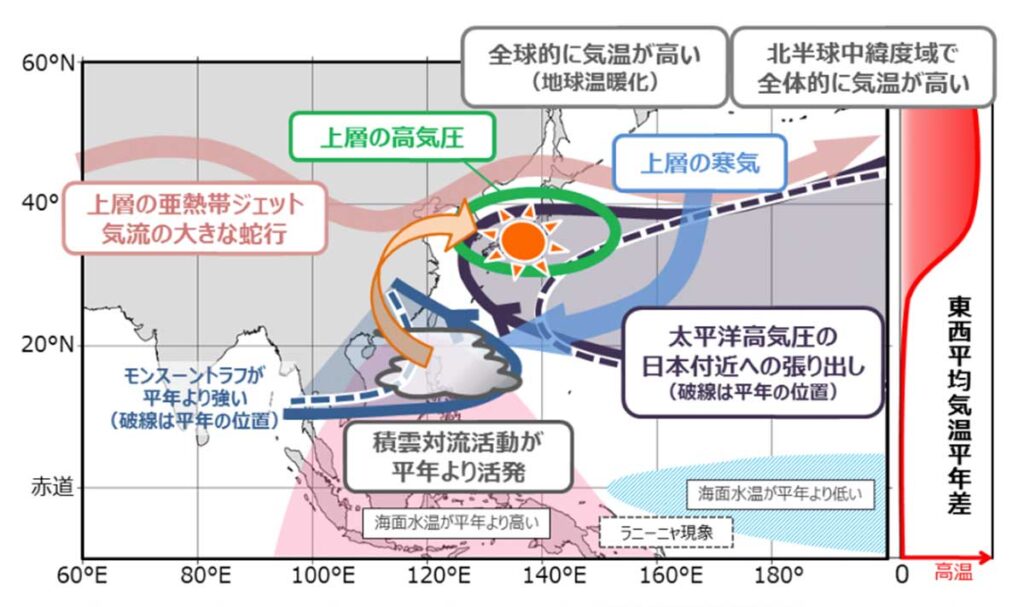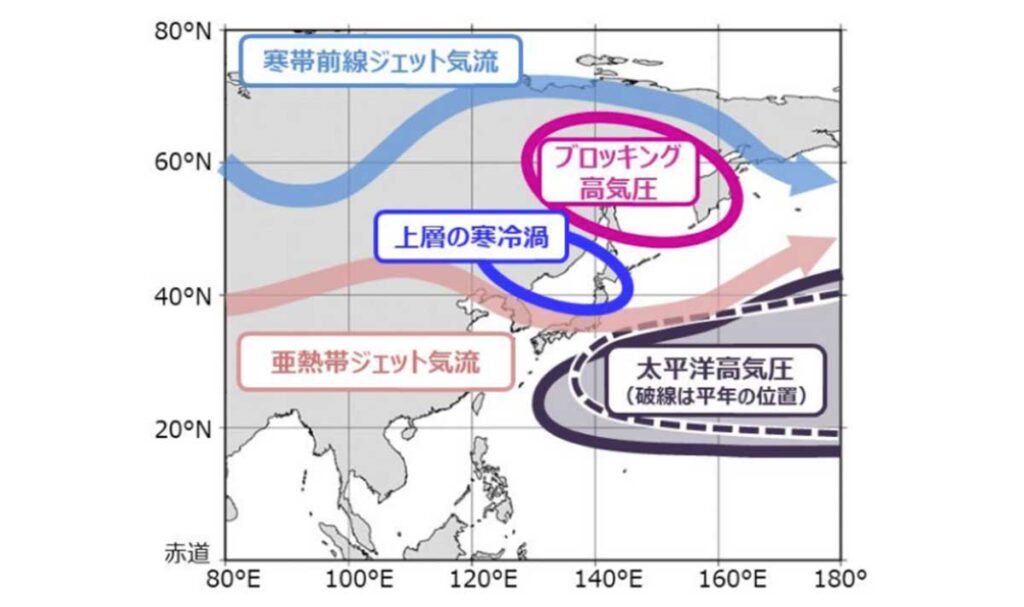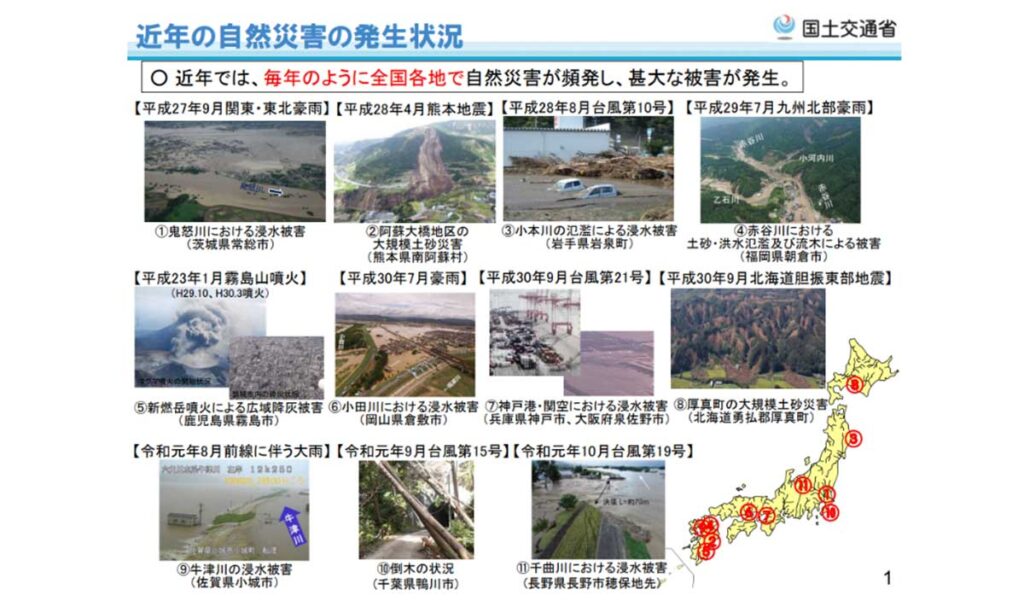Column
2022年09月25日
Summary of natural disasters in summer 2022
September this month is a month in which interest in disaster prevention is increasing, with September 1 being designated as Disaster Prevention Day and typhoons occurring. Disaster Prevention Day was originally established in 1960 because the Great Kanto Earthquake occurred on September 1 and falls on the 210th day when typhoons are said to strike frequently, and it seems that it became a day to conduct awareness raising activities such as disaster prevention drills.
Unfortunately, this year has also been hit by a devastating natural disaster. First of all, I would like to pray for the earliest possible recovery for those who have been affected by the disaster. In this article, with the meaning of fostering awareness of disaster prevention in the future, we have summarized the weather-related disaster events that have occurred so far this year. Unfortunately, this year has also been hit by a devastating natural disaster. First of all, I would like to pray for the earliest possible recovery for those who have been affected by the disaster. In this article, with the meaning of fostering awareness of disaster prevention in the future, we have summarized the weather-related disaster events that have occurred so far this year.
I would like to summarize from a bird’s-eye view the damage caused by the occurrence, the weather mechanisms including the relationship with global warming, and recent trends in countermeasures. I hope that it will be a reference for discussions such as “Why and what kind of natural disasters will occur this year, and how will we deal with them in the future?”
■ 2022 flood event in Japan
In Japan this year, flood damage due to heavy rains occurred in July and August. In addition, although the damage was relatively small, heavy rains were also occurring in June and typhoons were occurring in July.
Heavy rain in August 2022
Recently, since August 3, 2022, heavy rains have fallen intermittently over a wide area such as the Tohoku region and Hokuriku region, resulting in record-breaking heavy rainfall. This heavy rain caused flooding in four first-class rivers, and flooding damage to houses occurred especially in the top river (Yamagata Prefecture) and the Goshiribetsu River (Hokkaido).
Including rivers managed by prefectural governments other than first-class rivers, as many as 132 rivers have been flooded. For example, in Niigata Prefecture, a levee broke in the Takane River in the Mikata River system, causing damage to 2,133 homes, the largest in the main rainfall event. Nationwide, 12 people were killed or injured and 6,689 homes were damaged, including 24 total destruction.
Details will be described later, but from the viewpoint of weather mechanisms, the heavy rain from August 3 to 5 was caused by the stagnation of the front and the inflow of a lot of warm, moist air into the front.
Heavy rain in July 2022Heavy rain in July 2022
The next major damage was caused by heavy rains that occurred mainly in the Tohoku region and Kyushu on July 14, 2022 ~ July 14, 2022. The heavy rains caused flooding in 28 rivers and caused damage to 1,719 homes across the country.
Especially in Miyagi Prefecture, levees have broken down on the Meito River and the Tsukikawa River, causing enormous damage.
Reference) The boundary of the embankment of the Nagita River https://www.youtube.com/watch?v=WDLnCu6UqJg
From a weather mechanism perspective, the heavy rains in July, like the heavy rains in August, were caused by the stagnation of the front and the influx of warm, moist air.
Heavy rain in June 2022, Typhoon in July 2022
The other two flood events are heavy rains around Hokkaido in June and Typhoon No. 4 in July.
Although the scale of the damage was relatively smaller than that of the above-mentioned flood events, Typhoon No. 4 in July caused 139 residential damage nationwide, including heavy rainfall of 120 mm/24 h in the Izu Islands (the average rainfall in the Izu Islands was around 190 mm per month) and five rivers flooding in Kochi Prefecture.
Unlike the above two incidents, this heavy rain is brought about by the influx of warm, moist air around typhoons and cyclones.
■Relationship with weather mechanism and global warming
Supplement about weather mechanisms.
If heavy rain is forecast, you will often hear announcements in the weather forecast such as “Heavy rain is expected on the Pacific side due to the influx of warm and moist air from the south.”
As a basic principle, rain occurs when warm, moist air gathers and is carried aloft by updrafts, causing water vapor to condense. Heavy rainfall in Japan country can be broadly divided according to the inflow of this warm, moist air and the way it rides updrafts.
First of all, the front line (the boundary between the warm air mass and the cold air mass) is stagnant and there is a continuous influx of warm, moist air that keeps raining. It occurs especially with seasonal stagnant fronts such as rainy season fronts and autumn rain fronts.
Secondly, typhoons (and highly developed low-pressure systems) cause a lot of heavy rainfall due to the influx of warm, moist air and updrafts. It is particularly likely to occur in the summer when the temperature and sea surface temperature rise.
Topographical factors are added to these to form linear precipitation bands, and patterns of heavy rainfall intensification are often seen.
The heavy rains in July and August, which caused major floods this year, were both due to the stagnation of the front, but the large scale of precipitation seems to be related to the La Nina phenomenon and the effects of global warming.

record high temperatures in late June ~ early July (Source: Japan Meteorological Agency, Abnormal Weather Analysis Study Group)

unseasonable weather in mid-July (Source: Japan Meteorological Agency, Abnormal Weather Analysis Study Group)
As is well known, global warming refers to a phenomenon in which the average temperature is rising year by year, whereas La Nina phenomenon refers to a phenomenon in which the sea surface temperature in a specific region of the tropical Pacific Ocean (from near the date line in the equatorial Pacific Ocean to the coast of South America) becomes lower than normal every few years. (Conversely, the phenomenon in which the sea surface temperature rises is called the El Niño phenomenon.)
In general, it is sometimes said that when the La Nina phenomenon occurs, Japan tends to become extremely hot, but in fact this year it continued to be very hot from June to early July.
The La Nina phenomenon is caused by the strengthening of atmospheric circulation near the tropics and the upwelling of cold deep ocean water near the surface. At the same time, the updraft increases in the waters near Indonesia, and the downdraft intensifies in the Japan, overhanging the vicinity of the Japan than the normal position of the Pacific anticyclone, and the temperature continues to be sunny in the Japan.
Coupled with the effects of global warming, it is thought that the area around Japan experienced record heat surges.
According to a study called event attribution, which examines the extent to which global warming has been affected by abnormal weather events, the impact of global warming is quite large in this extreme heat wave (without global warming, the probability of occurrence would have been quite low).
At this time, a large flood occurred in Pakistan, but it has been pointed out that the subtropical jet stream may have meandered greatly due to the activation of updrafts and cumulus cloud convection activity in the vicinity of Pakistan in conjunction with the above-mentioned waters near Indonesia.
As a result, a cold vortex in the upper layers of the trough of high pressure that brings about unstable atmospheric conditions is persistent, and the Pacific anticyclone is pushed down to the southwest, and the front is stationary near the Japan (Tohoku region), bringing heavy rain.
In addition, on August 3~, due to the influence of Typhoons No. 5 and No. 6 moving northward in the East China Sea, the inflow of warm and moist air into the Tohoku region was continuous, and a localized linear precipitation band was formed due to topographical factors, which brought further heavy rainfall.
Although it cannot be said that all the heavy rains that occurred here were due to the effects of global warming, considering that the inflow of warm and moist air has become a driver of heavy rain as described above, it is highly likely that the increase in the amount of water vapor contained in the air due to global warming has led to an increase in the intensity of heavy rain.
Flood events before 2021 in Japan
In fact, rainfall across the country has also been on an upward trend over the past 50 years or so.
Looking back on the period before last year, typhoons, frontal stagnation, and linear precipitation bands such as Typhoon No. 14 in September 2021, heavy rains in July 2020, and the East Japan Typhoon in 2019 have caused heavy rains and flood damage every year.
In particular, the 2019 Higashi-Japan Typhoon caused enormous damage, including the deaths of more than 100 people and the damage to more than 13,000 homes.

https://www.mlit.go.jp/river/bousai/bousai-gensaihonbu/1kai/pdf/sankou.pdf
■Flood events overseas (including non-floods)
Many such floods occur outside of Japan.
Recently, as mentioned above, flood damage in Pakistan has become enormous. The average rainfall in July 2022 exceeded 170 mm, nearly three times the normal level, and more than 1,000 people died. There are reports such as “the worst in history” and “one-third of the country is submerged”.
In contrast to flooding, drought damage has also been enormous.
In August 2022, the European Commission issued statements such as “the worst situation in at least 500 years” and “climate change is becoming more pronounced every year”.
Not only are wildfires causing damage in Spain and Portugal due to heat waves, but in Italy and France, the decrease in water storage capacity has seriously affected hydroelectric power generation and the water cooling systems of various power generation facilities.
In Japan, around May, a drought caused an incident in Aichi Prefecture in which a factory could not operate due to a shortage of water.
■Future measures
Going back to flooding, how to implement flood control efforts in the future is important. Taking into account the impact of climate change, we believe that it is time to once again appropriately assess the risk of flood damage and take necessary measures.
Last year, in 2021, a revised version of the Watershed River Bill came into effect. This is considered to include implications for measures against the effects of climate change. In the rivers that suffered the above-mentioned damage, it is also emphasized that it is necessary to take measures that require consensus building with landowners in the surrounding area, such as strengthening levees and expanding the width of river channels.
The concept of the revised bill is to “work on flood control not only in river management but also in the entire watershed, including upstream and downstream, as one rock,” and I believe that it is necessary to devise and implement measures in cooperation with landowners in the surrounding area.
In order to build consensus among such a wide range of stakeholders and move forward, we believe it is important to appropriately conduct flood risk assessments that take into account the effects of climate change. We believe that the need for risk management is increasing even more for general companies, as evidenced by the fact that TCFD reports require risk assessments and information disclosure of physical risks such as floods.
I sincerely hope that we will be able to create a future that minimizes disaster damage by utilizing the latest climate science knowledge and data, conducting proper risk assessments, and appropriately implementing PDCA cycles.
■Gaia Vision’s Services
Gaia Vision provides a variety of services related to the flood risks described in this article, including risk analysis of companies, support for efforts to improve resilience, and support for information disclosure related to decarbonization and climate change such as TCFD. By using the climate risk analysis application Climate Vision, it is possible to easily analyze climate scenarios and assess physical risks in response to information disclosure. If you have any problems analyzing or disclosing information on climate change risks, please contact us.
Bibliography
- Tokyo Fire Department Disaster Prevention Day and 210 Days
https://www.tfd.metro.tokyo.lg.jp/libr/qa/qa_59.htm - Ministry of Land, Infrastructure, Transport and Tourism Disaster and Disaster Prevention Information
https://www.mlit.go.jp/saigai/index.html - Fire and Disaster Management Agency Disaster Information
https://www.fdma.go.jp/disaster/info/2022/ - Japan Meteorological Agency Abnormal Weather Analysis Study Group
https://www.jma.go.jp/jma/press/2208/22b/kentoukai20220822.html - JETRO Pakistan suffers worst level of heavy rain in history
https://www.jetro.go.jp/biznews/2022/08/cf3480acbcbaf2b8.html - The occurrence of natural disasters in recent years
https://www.mlit.go.jp/river/bousai/bousai-gensaihonbu/1kai/pdf/sankou.pdf - The Japan Economic Newspaper Europe’s drought ‘worst in 500 years’
https://www.nikkei.com/article/DGKKZO63834700Z20C22A8EAF000/
News
- 2024年05月10日 Gaia Vision is listed in “Summary of Recommended DX Service and Solution Providers”.
- 2024年05月01日 Gaia Vision is listed in “Summary of Recommended DX Service and Solution Providers”.
- 2024年04月16日 Gaia Vision is listed in “Summary of Recommended DX Service and Solution Providers”.
- 2024年04月14日 Gaia Vision is listed in “Summary of Recommended DX Service and Solution Providers”.
- 2024年03月29日 Gaia Vision is listed in “Summary of Recommended DX Service and Solution Providers”.
Column
-
-
-
-
-

